#*my other shawl projects
Text
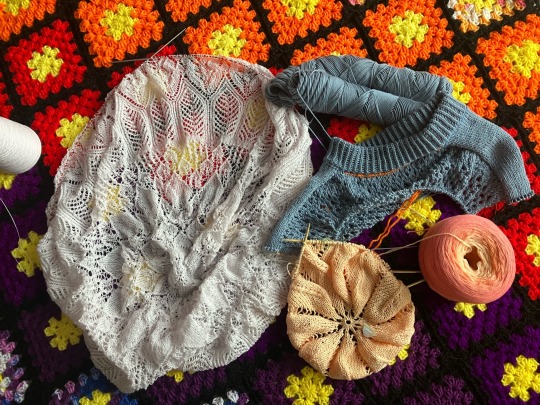
Been busy enough to justify a full round up for this WIP Wednesday. The TL;DR being that I'm back to being fully lace brained.
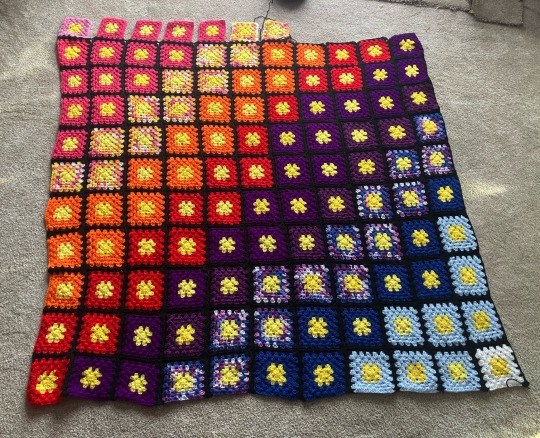
Blanket 10 is NEARLY finished. I've started attaching the last row and just need to finish out this row and then do a border (and give him a good wash, I've owned some of this yarn for years and it smells a little dusty). The nights are starting to get really cold here so I'll be happy to have it done, I just gotta force myself to work on it.
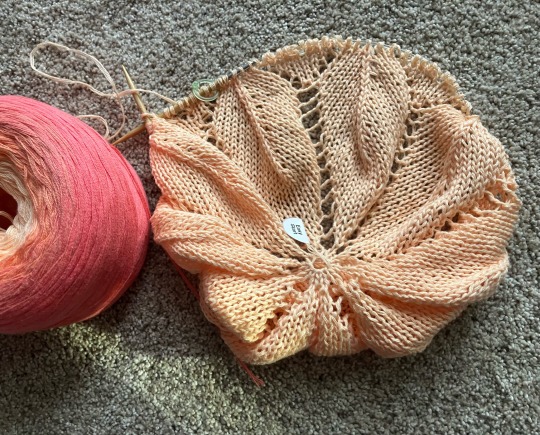
Doily 14 (Yarn | Pattern) needs to go on a longer needle but other than that is very fun and cute. I've decided to put it down for a bit to work on the next two projects but I expect when they get boring I'll go back to this. This pattern is surprisingly simple for a Neibling as long as you're prepared for the long pattern rows. Absolutely going to have to break out the washi tape to mark off my rows for the second chart, but the first one has been very easy lace knitting.
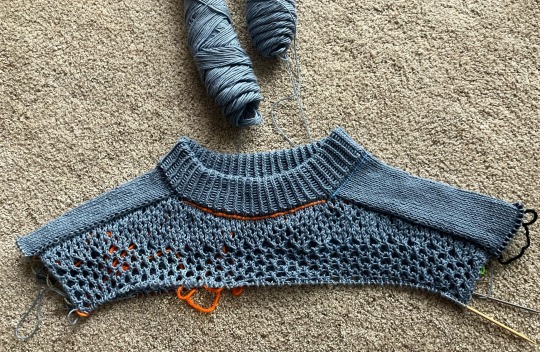
Unnamed project aka me fucking around to see if I can freehand this sweater design. I had started with a two row lace ("Honeycomb lace" from A Second Treasury of Knitting Patterns by Barbara G Walker) but honestly didn't find it fun to knit. So I transitioned to a favourite of mine (ssk, k2tog, yo twice). It's going a lot faster now tho it looks a little weird. I'm going to knit to the underarm and if it fits, it stays. If it's too small I'll rip all the way back and redo the shaping in this lace pattern instead with longer shoulder saddles. It's unfortunate that I didn't like knitting the honeycomb lace, I really like how it looks, I'll have to try swatching it in different yarns to see if the problem is just that this yarn has zero stretch (100% cotton).
I have decided I will put short sleeves on this tho. I had planned to just add ribbing for the arms but I saw a drop shoulder vest in a similar style and did Not like it, so this just saves me from having to rip back. I also think I'm going to have to leave this cropped, I'm not a big crop top person but with this yarn being cotton, having a full length body along with the sleeves is going to have the neckline very stretched. There may be no helping it regardless but there's no harm in trying. I imagine if this is does become something I wear it'll either be in the dead of summer or layered over a button up/some sort of top anyway, so a crop wouldn't be too uncomfortable.
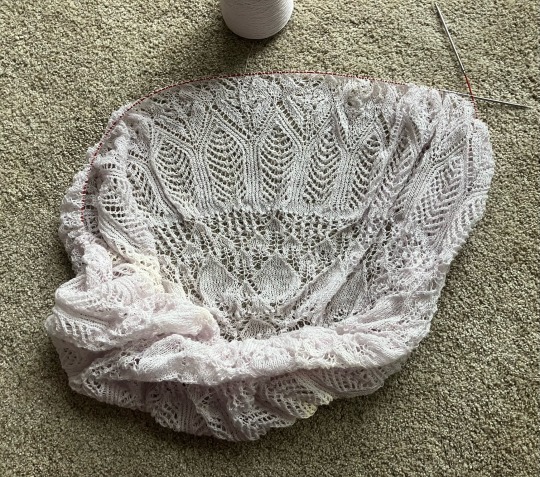
Last but certainly not least is Shawl 14 (Pattern | Yarn). My precious Evenstar is coming along very well, I'm actually on the second to last pattern row before the set up for the border. I know the border is going to be a slog but I'm excited for it regardless, he's huge even all compressed on the needles. My self imposed deadline for him is April, but the border is only 56 repeats. If I can do one every other day I should be right on time, which sounds do-able even tho I know I'll get bored by the halfway point.
I need to keep an eye out for patterns for this yarn, I have a whole second cone plus what'll be left after I finish this shawl. These cones staring at me will probably be the push I need to settle on an Orenburg shawl pattern. (Or possibly a large Neibling, or one of MMario's patterns.)
#knitting#knitblr#lace rot#wip#wip wednesday#project: blanket 10#project: shawl 14#project: doily 14#i haven't really touched shawl 15 so i didn't feel it necessary to include him (also it took me an hour to write up this much anyway)#i'm procrastinating from working on blanket 10 lmao it just makes me so eepy. heavy and warm blanket = nap time.#I gotta find something interesting to listen to while crochet it. I watched Astroid City with my dad and tried to work on it#but got so distracted by the visuals I made like 1 dc every other minute.#also my new cellphone camera is fucking awesome in comparison to my old one holy shit#it's like i just put my glasses on except they're not scratched up for once
48 notes
·
View notes
Text
thinking about knitting an heirloom wedding shawl just for fun
#knitting#knitblr#lace rot#i have the yarn for it already.#…i should probably finish my other knitting projects#*my other shawl projects#but i’ve misplaced my bead hook and don’t know where it is#and i need it for those projects#bones.txt
54 notes
·
View notes
Note
hey I did a quick peek and couldn't find the pattern for the shawl on rav!
how did you get ahold of the charts etc I'd love to join in on the kal!
yeah, the designer has unfortunately stopped selling her patterns - i ended up messaging a couple people in the ravelry projects tab to see if any of them would be willing to share their copy with me, and one of them graciously obliged!!
i uploaded it to google drive here, have fun~
edit: OH ALSO I ALMOST FORGOT, there's a chart error!
the one i circled down at the bottom there in the center panel chart i'm pretty sure is supposed to be a left-leaning decrease, not a right-leaning one, the whole rest of the chart is perfectly symmetrical so that's probably not on purpose XD

#dracula's bride shawl#knitting#lace knitting#knitblr#topcatnikki#dawnasks#sorry this took so long i've been away from my computer all day#i'd love to see how yours turns out!!#the pattern wasn't designed to have the center lace panel be in a different color the way i'm doing it#but all you have to do is cast on two more stitches than it says to#and add them to either side so there's two stockinette stitches at the edge of the center panel instead of one#and put the intarsia join between them#so it goes wing chart + one extra stitch in wing color -> intarsia join to spine color -> spine chart as written#-> intarsia join back to wing color -> one extra stitch + mirrored wing chart for the other side#if that makes sense?#i can walk through it in pictures later if that would help#or you could do the sane thing and NOT wildly overcomplicate the project like i did lmao#either way have fun!!
27 notes
·
View notes
Text
WIP Wednesday
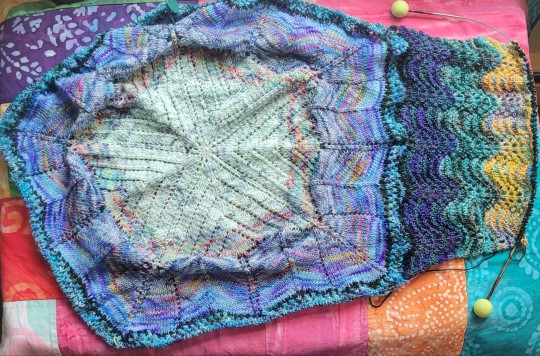
The Supernova mkal is slowly growing! Clue 4 was released last night, but I'm still catching up on Clue 3. Once this side is finished, it looks like I'll mirror it on the other side and have a somewhat more triangular shawl shape. I'm really excited to see how it looks once I'm done with these clues!
MKAL pattern link

I also started Shawl 2! Yarn is another destash yarn with no label, but it feels like mohair or a wool blend of some sort. It likes to felt, so frogging doesn't seem to be as much of an option on this project. I'll just have to be extra careful with the lace sections!
Pattern is the Sparrowette shawl on Ravelry
#knitting#knitblr#shawl 2#mkal 1#supernova mkal week 3#the other two projects are sort of in hibernation until I finish at least the mkal#which i hope to have finished by my birthday#i should? there's only a little left now#i actually hope to catch up by the release of the last part but we'll see#also apologize for the lack of updates it has been a week and my mental health has tanked lately#hoping to get back on track though
14 notes
·
View notes
Text
since finishing it this morning i have a) worn my shawl around the house when i got chilly b) used it as a full-body blanky when i took a nap earlier c) wore it on an outing and it was windy and chilly and it kept me snuggly and warm outside :3 and d) used it as a lap blanky (current state). honestly i think this is the best crochet thing ive ever made
#other than mayyybe my short sleeve cardigan that was a good one#ranking my big crochet projects 1. this shawl 2. rainbow cardigan 3. paul mccartney granny square waistcoat 4. green + black sweater vest#5. red/ourple/orange sweater vest (nice but doesnt fit me very well)#im excluding the crochet accessories that ive made but i LOVEEE how this turned out so it gets top spot regardless i think#emi's meandering jotts
7 notes
·
View notes
Text
i kinda wanna sell crochet work but I'm scawed 🙇 online shops seem like so much work aaahhhhhhh
#my mom says i have an eye for fun colors and unique projects so it must be true !!!!!#🥺#but i can crochet while lying down which is. huge#i started like.. two months ago? but im kinda obsessed. this shawl im working on... yall. yall.#i made this one dice tray and immediately wanted to try one with an embroidered dragon#so im like. i can make dice trays and bags with unique embroidery.. like cr or other dnd references ....#the dragon one looks cool but the backside is meh because embroidery. which is annoying bc both sides will be visible at points#bleh bleh bleh#also i could start on etsy. i suppose. i just know etsy takes an obnoxious amount of money#and crochet work is Already hard to price
2 notes
·
View notes
Text
trying really hard to apply the idea of Make Bad Art to amigurumi
the problem is that it's hammered in really hard that you Absolutely Cannot let Any filling show through, and keeping that kinda tension completely destroys my hands. like to the point where i haven't been able to do anything for the past week and i Know my current amigurumi project is partly to blame for that bc it has been Exhausting
but i wanna make things. and in this case it means i gotta make them badly
#rip current project youre gonna get tension switched halfway through#at least its assembled from pieces so#im gonna finish the current piece someday with tight tension#and then loosen up for the rest#and just deal with how it ends up looking#chatter tag#'oh just go down a hook size then!' if i go down another hook size the yarn literally wont stay on the hook anymore#i was not made to crochet aran weight yarn with a 3mm hook. i am not doing that#i have a love-hate relationship with amigurumi but my current project is so cute and i want it to exist#i have both my current projects just sitting on my desk and theyre haunting me#even when my hands recover i wont be able to work on them bc i need to catch up on homework :(#this is mainly me trying to untangle my thoughts tbh#(other current project is a shawl with very gay motivations behind it)
3 notes
·
View notes
Text

Current state of the shawl! I know the photo is at a bit of an odd angle, but the shawl is knit on the bias, and will essentially form a long parallelogram. You can see, somewhat anyhow, the open areas that the yarn-overs create in the pattern. I'm pretty happy with the colors so far and the way things are working up. It looks stripier here than I feel like it does in person (other than that transition from the green mini-skein into the knitpicks muse speckled yarn). I'm close ( knock on wood - i swear i am never so superstitious as hen I'm knitting and scared of errors or crises) to finishing this skein of Muse, and will be going on to the first skein of Wildflower Yarn's Unicorn Poop (:DDDDD - the name gets me very time, smile inducing)
I feel like I am the slowest knitter ever, and I am going to be making this thing til idk armageddon, the universe dies its cold death, or I can find a pair of shoes that makes my feet look cute (the first two are more likely - TRUST.) . However, the fabric is soft and so *bouncy*; it is eminently squishable! This color palette too just is a joy to look at. It's a lucky charms marshmallow of a thing, a my little pony pastel princess of a shawl. So, if i can manage to finish it before the end of forever (without any disasters- told you, superstitious when knitting... (¬_¬)' ) I think I just might love curling up in this thing.
#knitting#knitblr#adventures in terrible knitting!#adventures in terrible knitting#this is the shawl that doesn't end - yes it goes on and on my friends - somebody started knitting it not knowing what it was..#and she'll continue knitting it forever just because (she's really slow at knitting ok and don't judge her for that plz)#i'm going to have to think of a name for this shawl - other than the pattern name - which iirc is the palette shawl#palette shawl by expression fiber arts#knit picks muse in glee speckled#wildflower yarn unicorn poop#mini skeins are also wildflower yarn from the 2022 yarn advent calendar they did#i am doing this all in aran/worsted weight yarns currently on size 10 needles#probs coulda gone larger needles still even for more drape but meh i am happy with that i am - but glad i went up from 9s#so - so far. so good (for third cast on of this project - which is why the superstition ok - i has my reasons.)
15 notes
·
View notes
Text
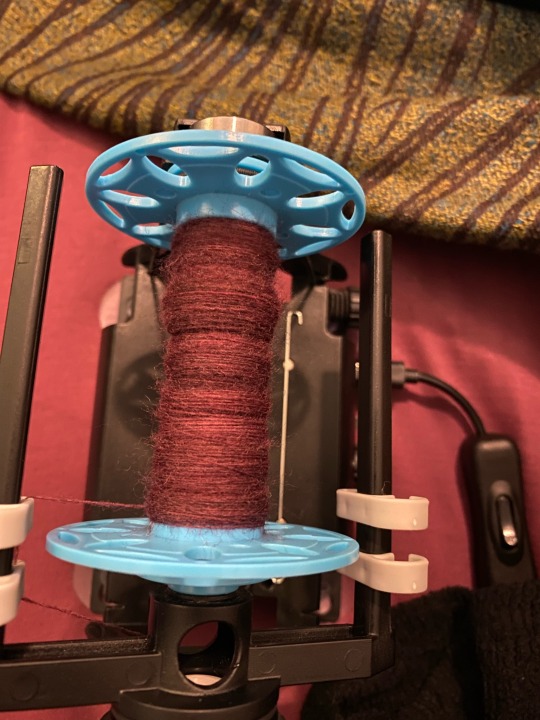
Finished the merino now it’s off to the targhee.
#sucks when all ur projects are big ones lol#and I don’t actually think I have enough wool for the size of project I want to make so now I’m looking for another good roving to add#on the one hand I don’t want to spend any money and there’s some beautiful chocolate alpaca in my stash#on the other hand I also have a braid of green at my parents house whomst I will be visiting soon#and I found a lovely braid at fabjous fibers that’s pink green and mostly grey#so I’m kinda thinking those two spun together would be nice#in fact I’ll probably buy it and spin them anyways even if it isn’t part of this project#the real question is do I want to buy it now or later lol#but yeah giant red shawl is also going well I just don’t think scrunched up lace looks good on camera#I also started a sweater on the needles and a skirt on the matching#but I…..probably will have to buy more yarn for the skirt…#but it’s knitpicks so I’m not too worried about lot matching#knitting#yarn#spinning#handspinning#handmade#wip#work in progress#wool#handspun#hand made#spinning wheel#electric eel wheel
5 notes
·
View notes
Text
I'm going to make a crochet mistake this week and Mom is going to kill me for it.
AKA I'm starting a THIRD doll bc this one is giving me brainrot.
#wings does things#maybe I can at least get to the limbs of the other dolls#so I can just rotate between all of their outfits?#for the record I've started Aoi from Ayakoi and Silk Adorned!Jamil#but I really want to make Vere from Touchstarved#Jamil has his body and arms done and I've written down the base pattern from that#so getting the base done is the easy part#then I freestyle it with the clothes and wigs#and Vere would need eyes painted#so I can buy myself like...a week of time before I go buy yarn#meanwhile my shawl is a good mindless project
2 notes
·
View notes
Text

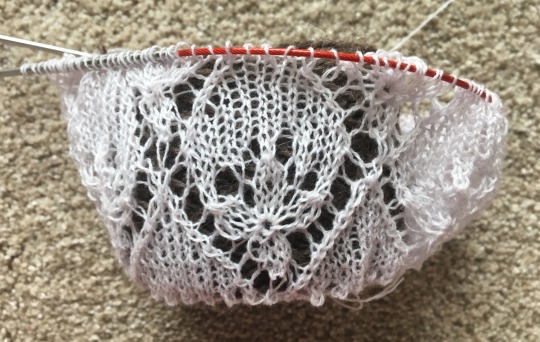
Shawl 14 | Pattern | Yarn
It's Wednesday and I'm almost done with chart one of my Evenstar! I was too impatient to wait to finish chart one before taking photos. Rn it fits comfortably on my 8 inch cables but after this chart the stitch count nearly doubles! 14 or 22 inch cables are in my future!
My tension is much looser on this weight needles/yarn than it would be for something I'm more comfortable with (specifically on the decreases) but I'm not worried about it. Looking at my swatches, a lot of that extra slack will probably block out with the tension from pinning.
#knitting#knitblr#lace rot#wip#lace knitting#project: shawl 14#very much enjoying this project. granted so far the difficulty has been in adjusting to the yarn size#thankfully not too many mistakes so far. for one of the k4togs i accidentally only did k3tog#but other than that i've not had any trouble keeping track of my pattern repeats without using stitch markers#which is always nice! i hate stitch markers so much.
36 notes
·
View notes
Text
I am the king of yarn
#please feel free to ignore this#making things#I bought yarn this weekend because I wanted to try making a hexagon cardigan for myself#+ I bought fancy yarn online because I found a cool shawl pattern and I want to try making it and I think it's something my mom might like#Anyway it's a lot of yarn for things people will wear#Not to mention all the extra I have for other projects I haven't finished#It's easy to collect yarn it turns out
3 notes
·
View notes
Text
i want to knit lace SO BAD
#my post#im hopefully going to get a bunch of nice yarn for my birthday#but its still 6 days off#and i got a bunch of shetland shawl patterns and i REALLY want to use them#BAD.#ny current project is BORING its not INTRICATE enough#i dont like baubles or wrapped stiches#i dont like doing them and i dont like the way they look#ill probably give this shawl to my grandma its her color and i havent made anything for her yet#i gave my other grandma the first shawl i ever made so fair is fair#gotta make sweaters for both grandpas too
0 notes
Text
I've never been terribly active here but I've returned to share my favourite patterns that make me slightly uncomfy and/or ready to star in an absolutely CRACKING sci-fi miniseries, please enjoy.

DEGEN ADULT EYES SWEATER by Lindsay Degen
Who WOULDN'T want this Biblically accurate sweater? The perfect attire for every horrifying occasion.

#22 Raglan Sleeve Pullover by Laura Zukaite
The rather staid naming of this sweater belies its Mad Max energy. After the apocalypse comes for us I hope we can at least dress like this.

Open Waters Shawl by Melanie Berg
A good shawl to wear to a duel to the death with your mortal enemy, if your mortal enemy has trypophobia.

Romanesco Jumper by Ranti Ehinmola
Honestly, the number of variations shown in the project photos for this pattern is amazing. Not only can you fulfill your dreams of looking like a 5th Element villain, you can do it your way.

DEGEN HOLE SWEATER by Lindsay Degen
This is a practical pattern for people like me who are in denial about living in a desert and stubbornly insist on wearing knitwear despite ample evidence this is a bad idea.

Wilderness by Martin Storey
I absolutely adore the 1950s farmhouse vibe of this photo and the beauty and poise of the model juxtaposed with the fact that she looks like a human bittermelon and she is fucking KILLING it
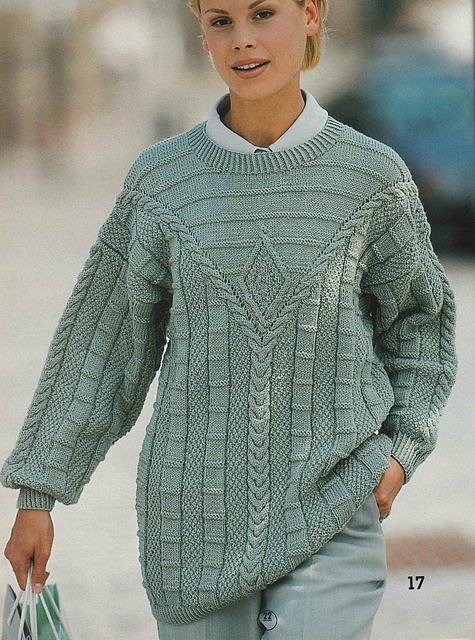
# 17 Patterned Sweater with V-Yoke by Sabrina/Sandra team designers
An unassuming mass-produced pattern from the 90s that, just coincidentally, looks like something you'd wear to head an intergalactic delegation.
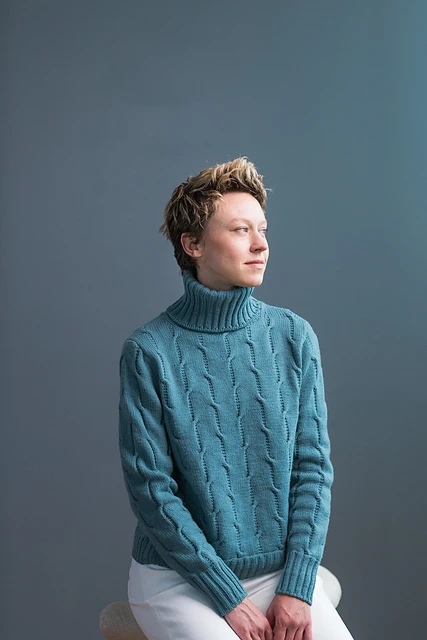
Blume by Norah Gaughan
Speaking of space sweaters, here's another that wouldn't look out of place on the bridge of a starship.
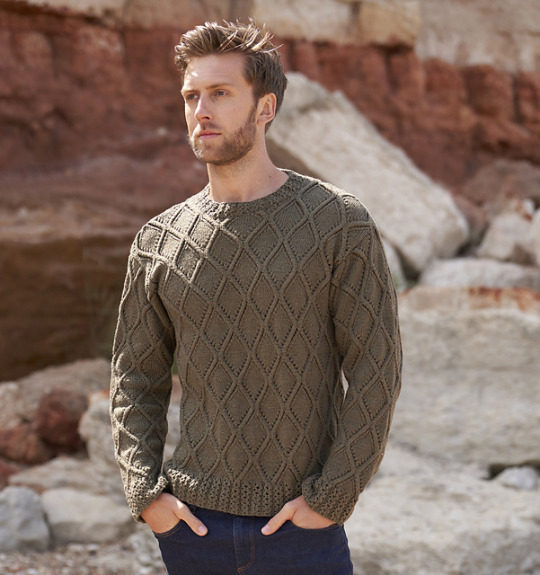
Mullion by Martin Storey
This one, on the other hand, looks more like attire for a... space council?

Space Odyssey by Anna Strandberg
This pattern is literally called "Space Odyssey". The author definitely knows.
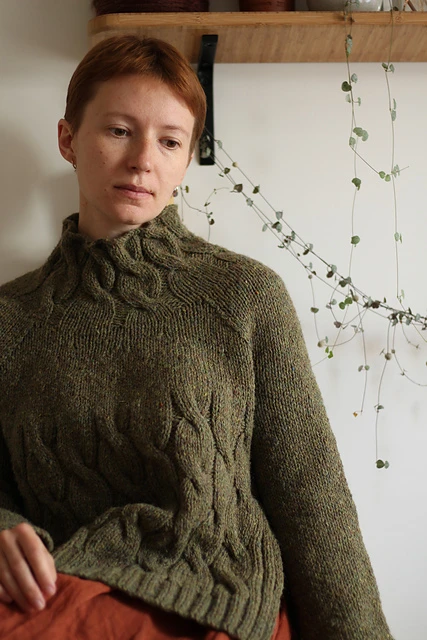
Dark Moss Pullover by Teti Lutsak
Bringing things back to Earth, the way these broad cables fade into the fabric reminds me of my desire to be buried in one of those mushroom suits after I die. Your interpretation may vary.

Waterbender by Yiğitcan / Pufido
The ultimate in dramatic sleeves.

Day Dreams by Stacy Collingham
Finally... I think the Power Rangers fought this sweater.
4K notes
·
View notes
Text
I finally published the project for my dice roll scarf that went viral last month. If you love dice games, you'll enjoy knitting this pattern.
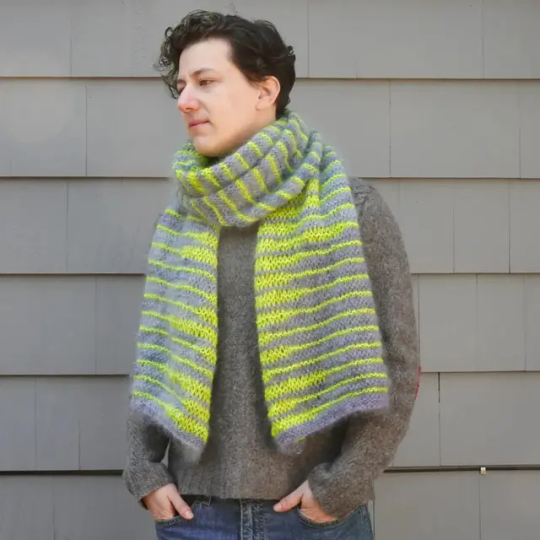
The color work in this project is determined by an algorithm, a set of rules that determine the final outcome. There isn't an exact set of instructions for this project. Instead, the knitter uses four 10-sided dice or a random number generator to pick the length of the colorwork in each row.
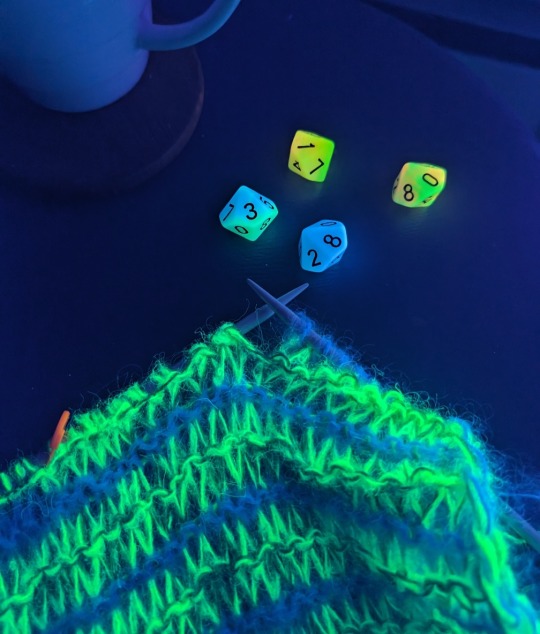
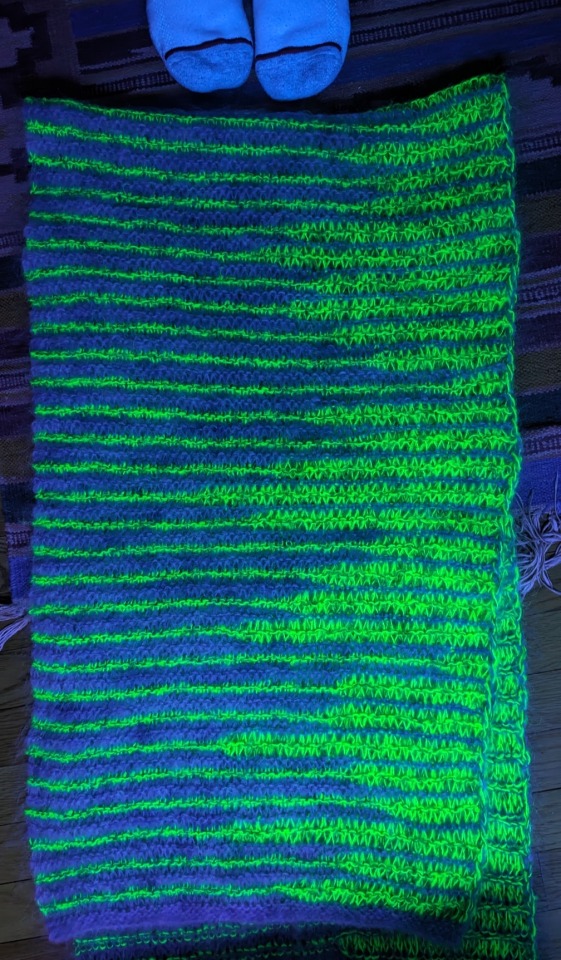
The result is a staggered stripe sequence along the edge of the shawl. There are trillions of unique outcomes, so no two projects turn out exactly alike. The pattern uses about 500 yards of yarn in total, but the amount of each color that you'll need is randomly determined. Before publishing, I wanted to find out the minimum and maximum amount of each color required to make the project and the probability of each outcome.

The knowledge needed to calculate the yardage was a bit beyond my skill level, but my friend Mary W. Martin helped me gather this info. I used an online probability calculator to find out the probability of each unique stitch count. The results are slightly different depending on whether you use four 10-sided dice (blue) or pick a random number (yellow), but 99% of all possible results fall within a very small range.
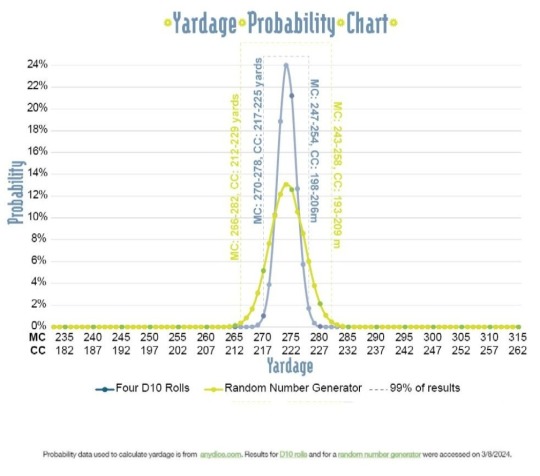
It was an interesting little tangent, but not hugely important to the actual knitting pattern. I can, however, confidently say there is a >99.9% chance that you'll need a 2nd skein of the main color. If you want to know more about the math, you should check out my project notes on Ravelry.
The thick and thin striped colorwork is created with a super simple "long stitch" technique. The pattern looks great in fluffy mohair or contrasting colors of basic wool and the instructions include some basic tips for substituting yarns or changing the gauge.

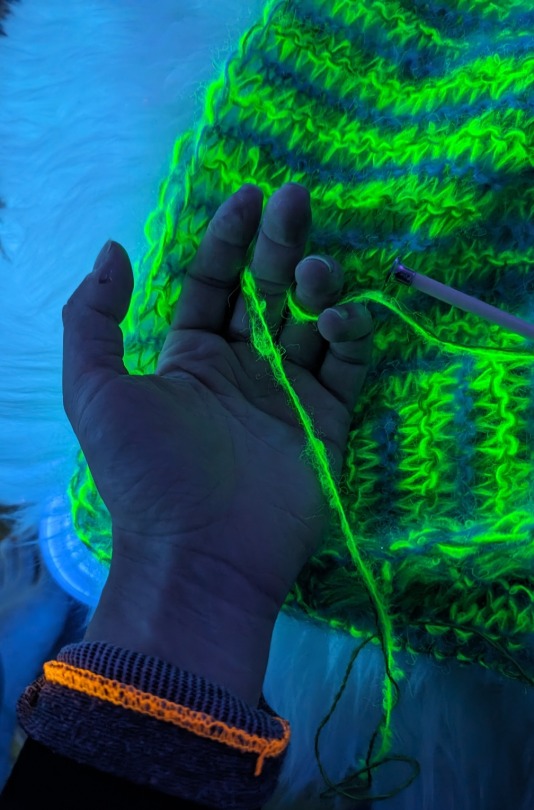
Finished Size: 18 x 68” (46 x 172 cm) rectangular wrap.
Yarn: Approx. 315 yards (288 m) of MC and approx. 264 yards (241 m) of CC. Yardage may vary, see notes on yardage below and yardage chart in photos.
• Main Color (2 skeins) - JMR Studio Worsted Weight Mohair, 245 yards (225 m) per 4 oz; 78% Mohair, 13% Wool, 9% Nylon.
• Contrast Color (1 skein each, both yarns held together) - JMR Studio Fingering Weight Mohair, 320 yards (293 m) per 100g; 63% Silk, 23% Kid Mohair, 11% Nylon, 3% Polyester Held with Lavender Lune Yarn Co. Suri Alpaca, 328 yards (300 m) per 50g; 74% Suri Alpaca, 26% Silk.
Yardage: The amount of each color used for this pattern fluctuates based on the random numbers used to determine the stitch pattern. MC uses approx. 233 to 315 yards (213 to 288m) and CC uses approx. 182 to 264 yards (166 to 241m). 99% of possible results fall within a much smaller range. The Yardage Chart shows the distribution of all potential yardage outcomes.
Needles: Size 8 (5 mm) straight needles, or size needed to obtain gauge. NOTE: Straight needles work best with long stitches. Circular needles with a thin cord allow the long stitches to tighten and stretch, making them harder to manipulate.
Gauge: 12 sts x 14 rows = 4 x 4” (10 x 10 cm) square in pattern.
Other Materials: 10 sided die or random number generator, stitch marker, scale, tapestry needle.
Generating numbers: In my sample, I used four ten-sided dice (D10) to choose a number between 4 and 40 sts. If you don't have dice, you can use an online app like RANDOM.org to generate your numbers. If you follow this link, you'll get a list of 63 integers between 4 and 40. NOTE: Each time you visit the link or refresh the page, the list changes. You can also just choose numbers as you knit.
Pattern is available on my website and on Ravelry.
667 notes
·
View notes
Text
April, 2024 | Shetland lace shawl

Hi there! It’s been a while. I’ve been kept busy by all my university work…and this shawl.
The shawl is knitted to celebrate the wedding of my friend (now friends, I should say). A wedding is really the perfect excuse for all the heritage crafts and heirloom projects that might seem too serious to gift in other occasions. I did ask the recipient beforehand if she would like it, though, and I was so, so honoured that I got an enthusiastic ‘yes’. I’m sure this sentiment is shared by many makers, whatever gift they are making.
Shetland fine openwork, a knitted lace, seems to have emerged with the beginning of the reign of Queen Victoria, who championed and popularised the craft. It was probably spread from the Isle of Unst to other parts of Shetland. What surprised me the most when I first read about it was that Shetland shawls and other lace pieces were largely exported as luxury items and rarely worn by islanders themselves. Women bought yarn from spinners and knitted mostly in their homes. They then took them to local merchants and exchange the finished objects for goods or (commonly after the 1880s) money to supplement the household income. The ‘supplement’ nature of this work probably means it was not compensated as much as a job outside the home would be for the same hours and skills. Besides, it was not always easy to spin an even 1-ply yarn at 1600 metres per 100 grams. For a piece of knitting with a large ‘plain’ area (i.e. only knit stitches), the unevenness was impossible to hide but could only be discovered after the area was worked. Then the maker had to either frog (unravel) the area or continue with the risk of the whole piece not being able to sell.
Whilst it is very reasonable to point out that Shetland ladies did not usually wear this type of lace (I’ve been to the Scottish Highlands once, in summer, and it was not fine lace weather), I imagine that at least for some, it wasn’t just about making money. Some sort of fulfilment must have been from the satisfaction of having a piece ‘properly done’ by continuing and adapting a traditional pattern, technique or material. I think this sort of satisfaction is also why many modern knitters are willing to spend hundreds of hours on lacework.
Intricate handknitted lace items can still be bought today (a quick search on Etsy would show many are form eastern European countries with a long and prominent craft tradition), but many are knitted for friends or family members. It always makes me so happy to see people share the gifts they have made, whether big or small, simple or complex. I joke with my online craft friends that no handmade fibre project can claim to be so unless they have a hair or two woven into it. It is the proof of existence for the maker, who tries to go against the irregular nature of handicrafts and, at the same time, accepts it. It is about wrapping up hours, weeks or months in one’s life, along with the songs they have listened to and the perfume they have worn and the memories they have made, and putting it squarely in someone else’s hands and saying: ‘All this, for you.’

A Wedding Shawl
I have not read anything about there being a standard form of ‘wedding shawl’ in the Shetland tradition. However, there is definitely a category of square shawls with similar sizes and a few construction methods. The samples I’ve seen mostly measure 1.5-2m on one side and have three parts: a central panel, four borders and a strip of edging. It is worked flat in garter lace from centre out.
Neither is there a standardised yarn weight. A widely available yarn is the Shetland Supreme Lace Weight 1-ply by Jamieson and Smith, which weighs at 400m/25g. The Queen Ring Shawl examined by Sharon Miller used a yarn at 700m/25g. From my experience, if you want the shawl to be a true ring shawl (i.e. you want to be able to pull the shawl through a ring) at the size of the Queen Ring Shawl (210cm on the side), go for 700m/25g or finer.
I chose a rectangular shawl because I had very limited time, but I did enlarge it because for me, an abundance of fabric does mean an abundance of cozy happiness.
Pattern
Shell Grid and Spider Webs Puzzle, pattern No.19 in the book Shetland Knitting Lace by Toshiyuki Shimada.
The names of the motifs are confusing. One motif (or two highly similar motifs) might just have two different names if they are produced in two different regions. Names do not mean everything, but I’ve had fun trying to match the motifs with names according to this article by Carol Christiansen at the Shetland Museum.
The double yarnovers (YO's) in the diamonds were called Cat's Eye, but perhaps the 'Spider Web' in the pattern name is referring to the three rows of double YO's in the centre panel. It has a really simple but effective edging.
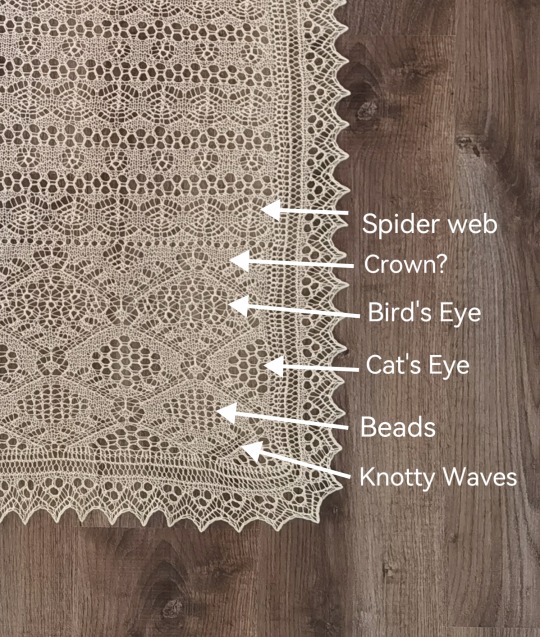
Yarn
Mermaid Lace, in colourway #naturel, sold by Great British Wool in the Netherlands. This yarn is 75% merino and 25% sea algae silk. ‘Sea algae silk’ seems to be a semi-synthetic plant fibre like viscose, with algae involved as part of the raw material. (At this price point I don’t think it has anything to do with sea silk, which is fibre produced by actual shells.) The brand name for the most popular product of its type is probably Seacell.
I bought the yarn, because I had never worked with this fibre before and was curious. What I like: it was a little cheaper than a wool/silk blend and has blocked very well. The whole skein was continuous so I didn’t have to deal with a single yarn joint. What I do not like: it lacks the sheen and smoothness of real silk and doesn’t feel as strong, although it doesn’t shed. In conclusion, I’d rather use a traditional Shetland 1-ply or another natural fibre yarn.
It's also worth mentioning that whilst I prefer to support small businesses, it was disappointing to have received a 93-gram skein when I had ordered 100 grams. It was one of those days between Christmas and the New Year and I somehow did not contact the customer service, but I really should have.
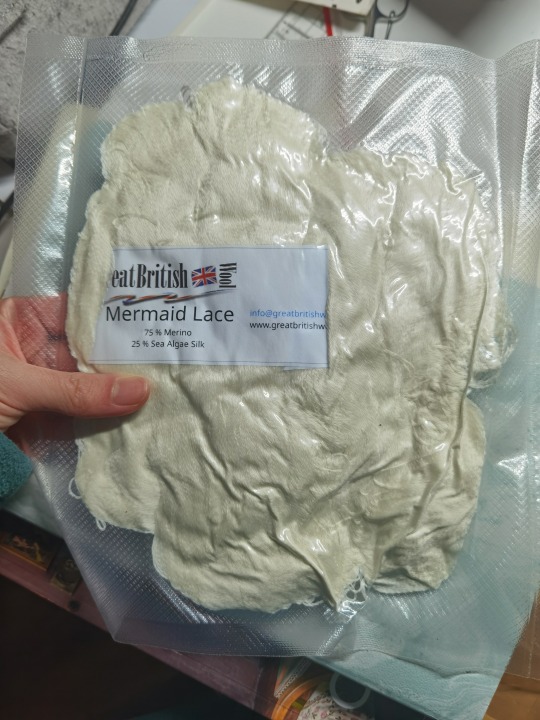
Needle
2.5mm 80cm circular needles. See modification below.
Modification
This Japanese knitting book follows Japanese sizing for knitting needles. The suggested size was no. 1=2.4mm. I figured that I could use a 2.5mm since I knitted on the tighter side, and in any case it was probably okay to make the lacework a little more open by going up a needle size.
I am not going to give out the pattern, but it is probably necessary to explain the structure of this shawl. The centre is knitted first, and then an edging is knitted onto it by picking up either live stitches or the vertical edge of the centre as you go (see schematic below). The four ‘corners’ of the edging have short-row shaping to help it lay flat. I know that traditionally people can achieve this by other methods, but I haven’t tried any of those yet.
I enlarged the pattern by increasing both the width and the length. I casted on 133 stitches instead of 101 for the centre panel and knitted Part B 8.5 times instead of 5.5. The spider web pattern in Part B requires the stitch count to be (something dividable by four) plus two, so I made one central increase before the spider web to get 134 and a central decrease after it to get it back to 133. Due to the openness of the lace, the change of one stitch is not visible.
The enlargement meant I had to recalculate the edging as well, because the number of stitches available for pick-up changed. Originally, at each corner you do two repeats with four short-row shaping each. I did 1.5 repeats following the original placement of short-row shaping in order to make the total number of repeats fit the number of edge stitches on the centre panel.
The pattern says to Kitchener-stitch the last row of the edging to the provisional cast-on. It just didn’t make sense because that would be two rows too much (the Kitchener stitch row plus the provisional cast-on row). To make the number perfectly fit, I knitted only ten rows of the last repeat (there were usually twelve in each repeat). Then I Kitchener-stitched the end to the provisional cast-on, following the lace pattern. I am quite proud of this solution because it is completely invisible.
Somewhere in the pattern it said to purl (looking from the right side). It seemed strange because the rest of the lace was entirely garter. I knitted those stitches and so far I haven’t sensed a ‘mistake’.
The pattern originally calls for 45 grams of yarn. I estimated (based on the increase of stitches in the centre panel) to need about 80 grams. I ended up using 86 grams. Besides the inaccuracies in my estimation, it was probably also because I knitted much more loosely than expected as it was difficult to tension the yarn tightly at such a weight. Like I've point out in the Yarn section above, I was lucky not to have needed more than 93 grams.
The original finished size is 53*118cm. I ended up with approximately 70*170cm.

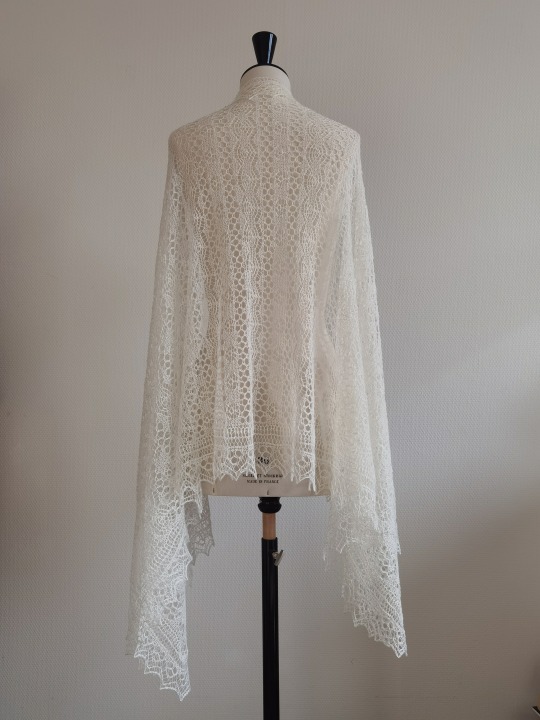


Conclusion
This shawl took about three months of my craft time i.e. one full day every week for three months and many mornings before I had to leave for university. Knitting outside my room just didn’t work because I was a) engaged in some other activities that made it difficult to steady my hands, and b) worried about putting a white shawl on any public surface.
The pattern itself is relatively straightforward. The first difficulty was, of course, to understand the instruction written in Japanese. Google translate was horrible so I had to rely on my knitting experience. Fortunately, much of the text description was also found in graphs and charts. Then I had to get my hands used to the tiny yarn. After that, it was only fiddly when I did the edging, because I had to turn about every twelve stitches, and by that time I was handling a giant cloud of stitches on my lap. It did give me a lot of time to go over my favourite documentaries and films, and the last bit of edging was surprisingly quick!
Traditionally, Shetland shawls could be sent back to the maker for maintenance. I think it only fair for me to offer that too because I don’t want a gift to become a trouble (same as how you do not use non-machine-washable yarn for baby knits).
In general, I am very pleased with this shawl. It does pass the ring test, despite not being a traditional wedding shawl size or thickness. I do have a whole lot of actual Shetland 1-ply in my stash, so I am really looking forward to taking my Queen Ring Shawl project out of hibernation in the near future.

Reference list for Introduction
Christiansen, Carol. Shetland fine lace knitting: Recreating patterns from the past. Marlborough: Crowood, 2024.
Mann, Joanna. 'Knitting the Archive: Shetland Lace and Ecologies of Skilled Practice'. Cultural Geographies 25, no. 1 (January 28, 2017): 91–106. https://doi.org/10.1177/1474474016688911.
232 notes
·
View notes